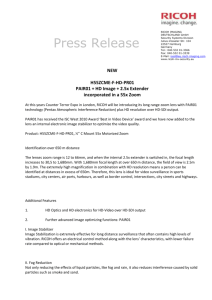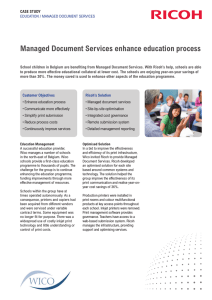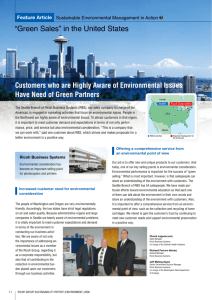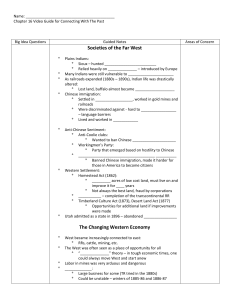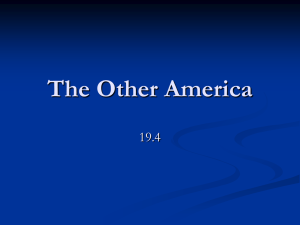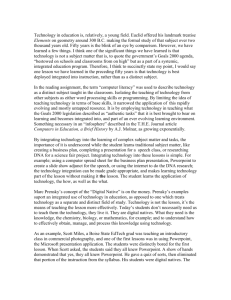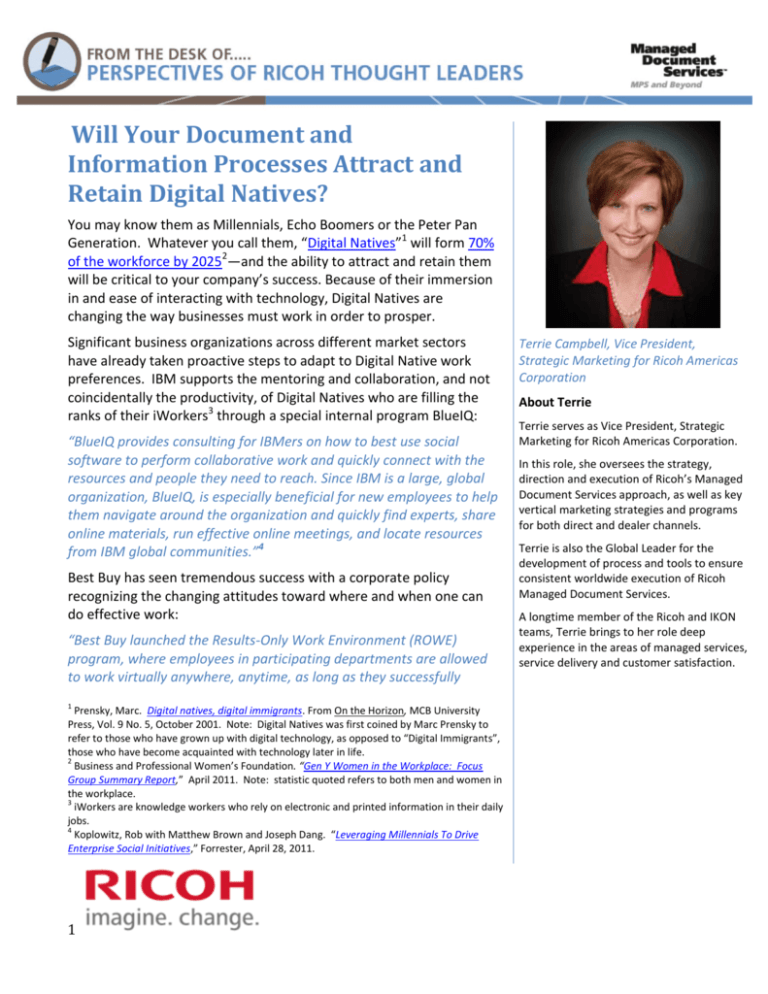
Will Your Document and
Information Processes Attract and
Retain Digital Natives?
You may know them as Millennials, Echo Boomers or the Peter Pan
Generation. Whatever you call them, “Digital Natives”1 will form 70%
of the workforce by 20252—and the ability to attract and retain them
will be critical to your company’s success. Because of their immersion
in and ease of interacting with technology, Digital Natives are
changing the way businesses must work in order to prosper.
Significant business organizations across different market sectors
have already taken proactive steps to adapt to Digital Native work
preferences. IBM supports the mentoring and collaboration, and not
coincidentally the productivity, of Digital Natives who are filling the
ranks of their iWorkers3 through a special internal program BlueIQ:
“BlueIQ provides consulting for IBMers on how to best use social
software to perform collaborative work and quickly connect with the
resources and people they need to reach. Since IBM is a large, global
organization, BlueIQ, is especially beneficial for new employees to help
them navigate around the organization and quickly find experts, share
online materials, run effective online meetings, and locate resources
from IBM global communities.”4
Best Buy has seen tremendous success with a corporate policy
recognizing the changing attitudes toward where and when one can
do effective work:
“Best Buy launched the Results-Only Work Environment (ROWE)
program, where employees in participating departments are allowed
to work virtually anywhere, anytime, as long as they successfully
1
Prensky, Marc. Digital natives, digital immigrants. From On the Horizon, MCB University
Press, Vol. 9 No. 5, October 2001. Note: Digital Natives was first coined by Marc Prensky to
refer to those who have grown up with digital technology, as opposed to “Digital Immigrants”,
those who have become acquainted with technology later in life.
2
Business and Professional Women’s Foundation. “Gen Y Women in the Workplace: Focus
Group Summary Report,” April 2011. Note: statistic quoted refers to both men and women in
the workplace.
3
iWorkers are knowledge workers who rely on electronic and printed information in their daily
jobs.
4
Koplowitz, Rob with Matthew Brown and Joseph Dang. “Leveraging Millennials To Drive
Enterprise Social Initiatives,” Forrester, April 28, 2011.
1
Terrie Campbell, Vice President,
Strategic Marketing for Ricoh Americas
Corporation
About Terrie
Terrie serves as Vice President, Strategic
Marketing for Ricoh Americas Corporation.
In this role, she oversees the strategy,
direction and execution of Ricoh’s Managed
Document Services approach, as well as key
vertical marketing strategies and programs
for both direct and dealer channels.
Terrie is also the Global Leader for the
development of process and tools to ensure
consistent worldwide execution of Ricoh
Managed Document Services.
A longtime member of the Ricoh and IKON
teams, Terrie brings to her role deep
experience in the areas of managed services,
service delivery and customer satisfaction.
complete their assignments on time. This shift increased productivity
41% at headquarters and decreased turnover by as much as 90%,
according to Ferris’ Four Hour Work Week”5
Both of these initiatives address the different ways Digital Natives
approach absorbing, using, and managing “business” information.
One difference is the use of information is as critical to the way they
live as it is to the way they work. ln fact, there is a blurring of the
distinction between the two. Another is the changing mentoring and
collaborative processes Digital Natives require in order for them (and
you) to succeed in the wired, global economy. The efficiency and
effectiveness of your processes can serve as a kind of proving ground
in your ability to attract and retain the best of this new generation of
iWorker.
Who Are Digital Natives and How Do They Use
Information?
In the U.S. at least, the Internet was already in place when Digital
Natives entered kindergarten—making them the first generation to
grow up in an online world. They went on to define the use of text,
chat and social media as a primary communication medium. As adults,
Digital Natives transact most of their personal business online (as
opposed to their predecessors who prefer in person or a voice over
the phone); immediate accessibility and self-service are the hallmarks
of the highest levels of service.
These behaviors and expectations carry over into their work life. A
recent speaker at World Economic Forum as part of the first Global
Shaper delegation, a group of 70 millennial leaders from around the
world, characterized her workday as a consultant:
“Last Friday, I had two work-related Skype calls, one to Nassau and
another to England, during my Amtrak train ride from Boston to New
York. For my work, I use Dropbox for online shared folders, Evernote to
store and categorize information, and Skype videoconferencing or
iPhone’s Facetime application to connect with my colleagues across
the world. This flexibility and technology give me the freedom to
operate my business anytime, anywhere”. 6
5
6
Dhawan, Erica. “Gen-Y Workforce and Workplace Are Out Of Sync,” Forbes, January 23, 2012.
Dhawan, Erica. “Gen-Y Workforce And Workplace Are Out Of Sync,” Forbes, January 23, 2012.
2
“The efficiency and
effectiveness of your
processes can serve as a
kind of proving ground
in your ability to attract
and retain the best of
this new generation of
iWorker.”
Let’s look at four characteristics of Digital Native information handling,
their expectations and specific behaviors.
They expect the same immediate access to information at work
as in their personal transactions—they make less of a
distinction between the two;
They do not want to be bound to a desk, but use the same,
smart mobile devices for work and personal life. This may
encourage working off-premises and outside of traditional
business hours. At the same time, these work preferences
might also limit the more traditional “hands on,” face to face
collaboration and mentoring relationships for effective
knowledge transfer;
They are energized, not stressed, by technological change: they
are unlikely to be satisfied with last year’s technology. Some 37
percent of Millennials (ages 18-27) globally say that state-ofthe-art technology is a vital consideration in selecting an
employer;7
They rely less on static information acquired through research
and more on experiential knowledge to inform their work. And
they share experiences and expect to collaborate online and
remotely through social media;
“These younger employees are driving the consumerization of IT, which
includes how business intelligence is delivered. They want business
intelligence to be as intuitive, social and collaborative as the tools in
their personal life. Thus traditional reporting and ad hoc query are flat
or declining, whereas data visualization in dashboards and interactive
visualization are experiencing growth.”8
Of course, Digital Native expectations and behaviors are not monolithic
across all cultures or geographies. The different rates of access to
newer technologies (from Internet-enabled desktops to smart phones
and tablets), as well as cultural attitudes toward work and personal life,
are also a part of the Digital Native panorama.
7
“Jumping the boundaries of corporate IT: Accenture global research on Millennials’ use of
technology.” Accenture, 2010.
8
Robb, Drew. “Gartner Taps Predictive Analytics as Next Big Business Intelligence Trend,”
Enterprise Apps Today, April 17, 2012.
3
“These younger
employees are driving
the consumerization of
IT, which includes how
business intelligence is
delivered. They want
business intelligence to
be as intuitive, social
and collaborative as the
tools in their personal
life. ”
Figure 1 Digital Native Expectations and Behaviors Vary9
Source: Accenture
But despite some variations the direction is clear—Digital Natives have
higher expectations for accessing business information and using the
newest technology for work and communications. The ability for your
processes to not only accommodate these behaviors, but to empower
them remains critical.
Processes Can Make or Break Your Appeal to Digital
Natives
Our own research, published earlier this year, provided clear evidence
that broken processes are detrimental to business success, both in
terms of increasing risk and stifling revenue opportunities in the here
and now.
In a Ricoh-commissioned global survey, 75.9% of respondents
experienced serious business risk and/or compliance issues as a direct
result of ineffective processes over the past five years—and the
second most frequently mentioned consequence (by 30.2% of
respondents) was that they lost key employees.10 We’ve all
9
“Jumping the boundaries of corporate IT: Accenture global research on Millennials’ use of
technology.” Accenture, 2010.
10
IDC White Paper Commissioned by Ricoh, “It's Worse than You Think: Poor Document
Processes Lead to Significant Business Risk,” doc#6352, June 2012.
4
experienced the frustration of being unable to find the information we
need to be productive.
Figure 2 When Processes Break, Key Employees Leave
Source IDC White Paper Commissioned by Ricoh, “It's Worse than You Think: Poor Document
Processes Lead to Significant Business Risk,” doc#6352, June 2012
It’s reasonable to expect broken information processes would be even
more frustrating to Digital Natives, given their expectations, and the
frustration would be compounded if older technology is thrown into
the mix. Taking a step back, frustrated Digital Natives may not hesitate
to find a more efficient and energized work environment, leaving you
with a growing talent shortage in the years to come.
Let’s look at some other potential disconnects between the way your
processes may work—and the way Digital Natives expect to work.
If Digital Natives expect:
Immediate access to information,
preferably self-service
They’ll be frustrated by:
Inability to locate silo’d information
and/or inaccessible to them because
of system incompatibilities
Slow response time in locating the
right information
Too many people to consult and
manual processes along the way to
getting information
Being blocked by security rules that
they don’t understand or are
perceived to be inconsistent
5
If Digital Natives expect:
They’ll be frustrated by:
Tracking down hardcopy (one third
of all business information is still on
paper)11
To be highly mobile (work from
anywhere) using the same device
for personal and work use
Lack of workplace support and
subsidy for Bring Your Own Device
(BYOD) initiatives
Gaps (lack of bridges) between their
communication styles and coworkers of earlier generations
Inadequate infrastructure to support
working remotely
Are energized, not stressed, by
changes in technology
Outdated (“boring”) technology
Inflexible processes that cannot
accommodate change
Slowness of getting to market with
new products due to sluggish
processes
Rely less on static and more on
experiential knowledge
Fixed processes with lots of
checkpoints and little opportunity to
try things out
Data heavy, not visual enough
Restrictions on use of social media
Lack of easy access to the
experiential stores of earlier
generations
The global survey also showed the upside of improving broken
processes, benefits that would appeal to Digital Natives and their coworkers.
Over 83% of study respondents indicated that optimizing customerfacing processes would increase revenue — on average by 10.1%.
Respondents estimated that they could speed the time to get products
11
IDC White Paper commissioned by Ricoh, “It's Worse than You Think: Poor Document Processes
Lead to Significant Business Risk,” doc#6352, June 2012.
6
to market by 13.4%, by streamlining new product development,
manufacturing, and supply chain functions.12
This responsive, more agile workplace is the kind of culture that
appeals to Digital Natives, enabling them to get more out of, and do
more with, timely information. When information processes are better
tuned, they can result in higher productivity, broader collaboration,
and greater agility—often using fewer resources (paper, toner, real
estate) as well as being great for your top line.
Initiatives to Attract and Retain Digital Natives
“When information
Making processes more appealing to Digital Natives takes some careful
planning and management of change.
processes are better
Process is paramount: identify where processes are clogged or broken
and develop a game plan for specific places you can streamline
processes and optimize information access. Look for opportunities to
transform information access to a secure, self-service capability,
similar to giving access to employee benefits online. Look to include
subject matter experts (who are likely to be Digital Natives) in the
planning and implementation phases of process improvements.
tuned, they can result in
Conduct regular process reviews—a recent study showed that a
surprising number of companies do not: 56% only spent up to one day
reviewing processes, and a little over a third of the respondents
admitted that they felt not enough time is spent reviewing
processes.13
Interestingly, employees agreed:
“When asked which single thing they would tell senior managers
about how to improve the way their business manages document
processes, the number one employee response (29 per cent) was to
more regularly review the way they work or manage processes and
business critical information.”14
12
“Organizational Blind Spot: The Role of Document-Driven Processes in Driving Top-Line
Growth,” IDC. September 2012.
13
“A New Perspective: Ricoh Document Governance Index 2012: Part 1: Business leaders puzzled
by process priority jigsaw.” Ricoh, November 2012.
14
“A New Perspective: Ricoh Document Governance Index 2012: Part 3: What employees really
think about the process puzzle.” Ricoh, November 2012.
7
higher productivity,
broader collaboration,
and greater agility—
often using fewer
resources (paper, toner,
real estate) as well as
being great for your top
line.”
Promote the Digital Native’s love of mobility and the latest technology.
If you aren’t in the vanguard of companies supporting and even
subsidizing tablets and smart phones that support new work styles,
consider taking a more strategic approach to your information
infrastructure. Supporting more mobile work styles will allow the
organization to benefit from a more blended work/home life.
Increase the channels and depth of experiential knowledge transfer to
Digital Natives by building bridges between workforce generations.
This is especially important to the youngest Digital Natives (born after
1990), referred to in one recent study as “Generation C,” for connect,
communicate, or change.15 Empower Digital Natives to be mentors
themselves, helping Boomers and Gen Xers learn to leverage mobile
devices and cloud solutions.
Finally, build your brand as a great place to work. Make sure that
talent management promotes the transformations you are making
supporting the latest devices, more open BYOD policies, and the
collaborative use of social media. Encourage Digital Natives to promote
your workplace through social media. And don’t forget your web
presence; your corporate sites should reflect the dynamic nature of
your culture—looking for information on your organization needs to be
a great experience, to demonstrate your processes are working
smoothly.
Conclusion
Your processes can be viewed as a proving ground for your ability to
attract and retain talent from the growing Digital Native workforce.
Improved processes also bring more immediate benefits in making
your business more agile and productive. And that’s a win-win for all
the generations in your workplace.
For more information on Digital Natives and the changes their use of
technology is bringing to the work place, check out these and other
blog entries hosted at our Knowledge Center
Millennials, the iPhone5 and Streamlining the Enterprise
Information Infrastructure;
Tablet Computing: A Small Pain with a Potentially Big Payoff
15
“A New Perspective: Ricoh Document Governance Index 2012: Part 3: What employees really
think about the process puzzle.” Ricoh, November 2012.
8
“Build your brand as a
great place to work.
Make sure that talent
management promotes
the transformations you
are making supporting
the latest devices, more
open BYOD policies, and
the collaborative use of
social media.”
Social Media: Aligning Information Infrastructures with Your
Hybrid Information Environment - Ricoh Managed Document
Services
Ricoh Company, Ltd.
Ricoh Company, Ltd. is a global technology leader, specializing in the
office and production printing markets. Ricoh works with organizations
around the world to modernize work environments and optimize
document efficiency. With more than 108,500 employees worldwide,
Ricoh operates in Europe, the Americas, Asia/Pacific, China, and Japan.
Ricoh’s worldwide sales were more than 2,016 billion yen ($21 billion
USD) in the year ended March 31, 2010.
Ricoh’s Managed Document Services (MDS)
Ricoh’s MDS approach is an extension and evolution of MPS, which
addresses the three fundamental functions relating to the entire
document management ecosystem of input, throughput, and output.
Ricoh’s MDS aims to streamline core business processes by focusing on
process, people, and technology and innovation to create a state of
continuous improvement. Ricoh aims to help organizations better
manage and leverage information for improved business outcomes
through a flexible, partnership-led approach. Services management is
the fundamental pillar to govern the print and document services
program, aided with expert consultancy as well as proven project and
change management methodologies. Ricoh is recognized today by both
IDC and Gartner as a leader in the industry.
www.ricoh.com
www.ricoh.com/mds/
Copyright 2012 Ricoh Company, Ltd. All rights reserved. All other company or product names
and trademarks are the property of their respective owners.
9

